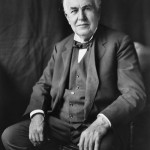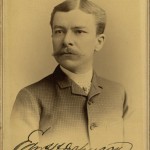The modern-day Christmas tree was adopted in upper-class homes in 18th-century Germany, and was quite the fire-hazard, as the tree was occasionally decorated with lit candles. These candles were often adhered to branches with melted wax, but were sometimes simply pinned to the tree. Around 1890, candleholders were first used, and by the early 1900s, lanterns or glass casings were used to hold the candles for safety as well as aesthetic purposes.
In 1880, Thomas Edison was looking for a way to market incandescent bulbs despite being expensive and requiring technical knowledge to operate (each bulb had to be hand-wired). To advertise his electric lightbulbs to every commuter on the nearby railway, Edison strung incandescent bulbs around his entire Menlo Park laboratory. A remote generator, located approximately 8 miles away, powered each bulb.
Two years later, Edward H. Johnson, inventor and Vice President of Edison’s electric company, had a similar idea. At his home on Fifth Avenue in New York City, he created a hand-wired display consisting of 80 bulbs, in a combination of red, white, and blue lights. These were strung onto a small Christmas tree, which was placed on a motorized pine box. The tree was set to spin six rotations every minute on an electric crank. Johnson quickly became known as the Father of Electric Christmas Tree Lights. “I need not tell you that the scintillating evergreen was a pretty sight,” proclaimed a reporter for the Detroit Post and Tribune. “One can hardly imagine anything prettier.”
.jpg)
Johnson’s Decorated Tree

Thomas Edison

Edward Johnson
Unfortunately, setting up electric lighting at this time was very time consuming and required a bit of technical knowledge as lights had to be individually wired by hand. The cost was also prohibitive, as a single string of lights cost $12 – nearly the equivalent of $300 today. During this period, there was also still a vast distrust of electricity, as it was a new source of power. Many parents were afraid of exposing their children to this strange, new energy. President Grover Cleveland eased this apprehension in 1895, when he requested the Christmas tree in the White House to be lit with hundreds of electric light bulbs. This event is widely credited to the acceptance of indoor holiday lighting. By 1908, insurance companies refused to pay for damages caused by Christmas tree fires, which were often caused by decorating Christmas trees with wax candles. Electric lights were a much safer alternative.
Albert Sadacca’s family owned a novelty lighting company. Sadacca saw a potential in selling this novelty lighting for use on indoor Christmas trees. Albert and his brothers organized the National Outfit Manufacturers Association (NOMA) by the 1920s. NOMA quickly became NOMA Electric Co. and controlled the Christmas lighting market until the 1960s.
About the Author: Jim Hilliard
I started Outdoor Lighting Perspectives back in 1995, since then we have franchised and now have over 35 offices around the country. Our business has grown to what it is today because of our extraordinary service. Thank you for your interest in Outdoor Lighting Perspectives.